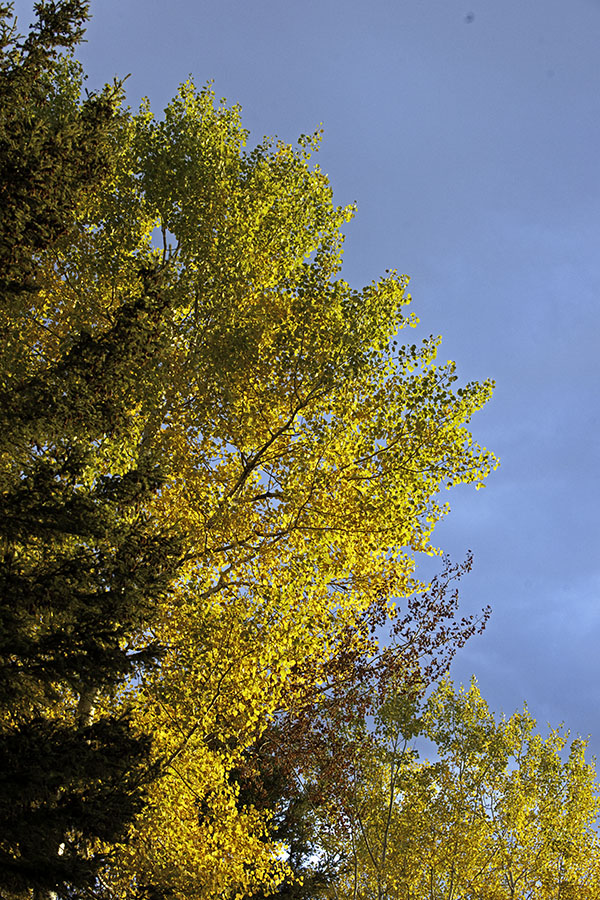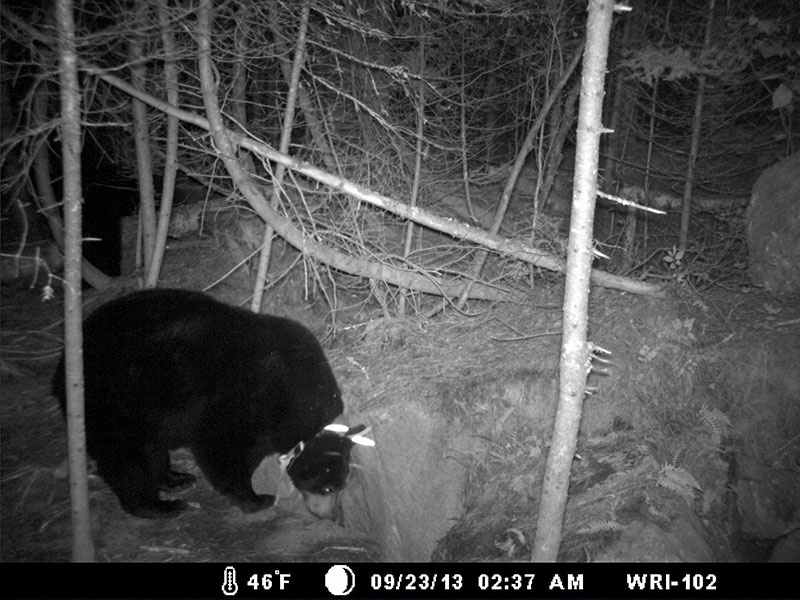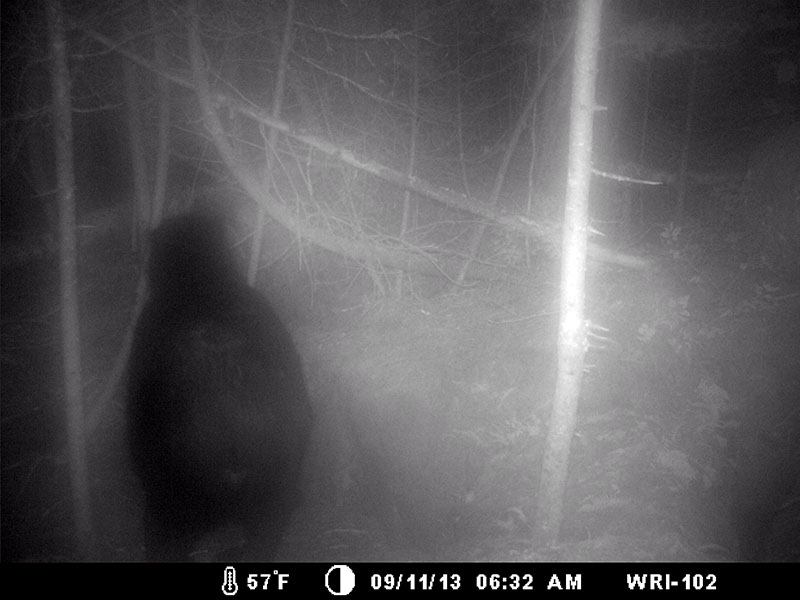Cole and Ember – UPDATE October 1, 2013
 Fall colorJune’s 9-month-old cubs Cole and Ember are finding food and will likely do okay, but seeing them on the trail cam without June yesterday made us long for June all over again. Even more poignant was seeing the cubs interacting with June on a Sept 21 trail cam video we received today.
Fall colorJune’s 9-month-old cubs Cole and Ember are finding food and will likely do okay, but seeing them on the trail cam without June yesterday made us long for June all over again. Even more poignant was seeing the cubs interacting with June on a Sept 21 trail cam video we received today.
 June visits rock den - Sept 21, 2013There was so much to learn from June—especially in the context of the 11,000+ GPS locations we had been receiving per year from her. What a story those locations were telling. What a story she had yet to tell. She was a research partner with a life and relationships—Cole, Ember, Big Harry, Lily, Jewel, Aster, and her other radio-collared neighbors. She was teaching us about habitat and the importance of certain forest components to forest management. She was teaching us about her travels and her memory of locations.
June visits rock den - Sept 21, 2013There was so much to learn from June—especially in the context of the 11,000+ GPS locations we had been receiving per year from her. What a story those locations were telling. What a story she had yet to tell. She was a research partner with a life and relationships—Cole, Ember, Big Harry, Lily, Jewel, Aster, and her other radio-collared neighbors. She was teaching us about habitat and the importance of certain forest components to forest management. She was teaching us about her travels and her memory of locations.
 Lily visits rock den - Sept 23, 2013We are hearing your concern about Cole and Ember and what should be done for them. Based on earlier research Aiding_the_Wild_Survival_of_Orphaned_Bear_Cubs.pdf, we believe Cole and Ember have a good chance of survival—especially since they are now visiting one of the community feeding sites. The relevant portion of the article begins on page 108. Here are a few paragraphs from it.
Lily visits rock den - Sept 23, 2013We are hearing your concern about Cole and Ember and what should be done for them. Based on earlier research Aiding_the_Wild_Survival_of_Orphaned_Bear_Cubs.pdf, we believe Cole and Ember have a good chance of survival—especially since they are now visiting one of the community feeding sites. The relevant portion of the article begins on page 108. Here are a few paragraphs from it.
To learn overwinter survival rates, we gave radio collars to 14 orphaned cubs more than 7 months old in northeastern Minnesota. Of these, two cubs soon were shot, two were killed by trains, and one died of unknown causes, reducing the sample for overwinter studies to nine. All nine made dens, showing that den construction is instinctive for cubs even though their mothers normally would make dens for them. All nine survived until spring. One was killed in spring leaving eight for continued study. Of these, at least seven survived past the time they normally would leave their mothers. The radio-collar of the eighth was removed (see below).
However, a confounding factor in the high survival is that 11 of the 14 orphans had access to supplemental food. These were orphaned because their mothers were shot as nuisances, and the human food sources used by the mothers were available to the cubs. As a result, many of them grew more rapidly than cubs with mothers.
The two that grew most rapidly ate their mother's carcass in late June and then supplemented their diets with garbage. These weighed 13.2 and 17.3 kg on 23 August and weighed 17.3 and 23.6 kg when they were killed by a train on 23 September of the same year.
Two orphans without supplemental food weighed 14.7 and 17.5 kg when their mother was killed on 10 August. Both survived past 3 years of age. A third without supplemental food weighed 13.2 kg when he was orphaned on 20 September He survived at least until the following 17 April when he weighed 7.7 kg. His radio-collar was removed at that time. His survival is doubtful because his weight was within the range where there is high mortality. Nine of 12 other yearlings that weighed less than 10 kg in spring died (Rogers 1983, and this paper). Altogether the data for orphaned cubs indicate that survival after July (approximately 6 months of age) is determined by more by food supply than by the presence of the mother.
Two orphans that ate supplemental garbage were radio-tracked to maturity. Both were females, and both took over their dead mothers' territories. However, one of them used only a small portion of her mother's territory until a neighboring female that had taken over most of it was killed (Rogers 1985). The two orphans produced their first litters at 4 and 5 years of age, as is normal for females that supplement their diets with garbage in northeastern Minnesota (Rogers 1985).
 Big Harry visits rock den
Big Harry visits rock den
Sept 11, 2013Cole and Ember offer chances to learn more. Sample sizes in the above study are low. More study is needed, and results would directly apply to bear management in learning survival of cubs orphaned in bear hunting season. Orphan survival information would help population models to better estimate bear populations. We are asking the DNR for permission to radio-collar Cole and Ember to learn how they fare as orphans. Will they stick together? Will they make adequate dens? Will they den together? Will they survive the winter? We are also asking permission to place Den Cams in their den(s).
Fall color is about at its peak here. Most aspens, birches, and maples are in full color and many leaves are beginning to fall.
Thank you for all your concerns and support. Thank you for all you do.
—Lynn Rogers and Sue Mansfield, Biologists, Wildlife Research Institute and North American Bear Center
All photos taken today unless otherwise noted.
